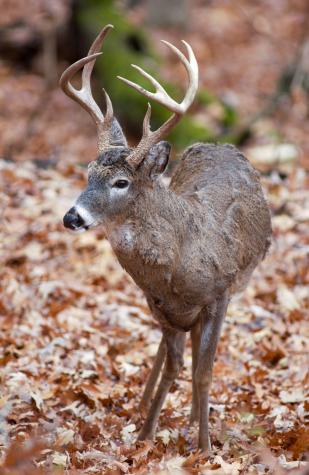COLUMBIA, Mo. – As the 2011 deer season comes to a close, hunters and landowners can learn about managing white-tailed deer from a new series of publications currently being developed by University of Missouri Extension and the Missouri Department of Conservation (MDC).
“The white-tailed deer is one of the state’s most valuable natural resources,” says Bob Pierce, extension fisheries and wildlife specialist at MU. Deer hunting contributes $1.1 billion annually to the Missouri economy and supports about 12,000 jobs.
MDC regulates Missouri’s deer population in rural areas through the hunter harvest, making private landowners and hunters the primary stewards of the state’s 1.4 million deer, Pierce notes.
“The publication series was developed to provide research-based information to help landowners and hunters make informed decisions and achieve management goals for white-tailed deer on their properties,” he said.
The first seven guides in the series are available free on the Web and as PDF downloads. More guides will be released in the coming months.
Quality Deer Management
In many parts of the state, the overall health and quality of the deer herd can be improved by applying a set of practices called Quality Deer Management (QDM), which has become increasingly popular among hunters and landowners.
Many people think QDM is mainly about shooting lots of does to produce a bigger population of bucks with big antlers. That’s not the case, says Pierce. The underlying goal of QDM is to promote a more balanced sex ratio and age structure within a particular deer herd, and to keep the herd’s population from exceeding the carrying capacity of its habitat, he said.
“QDM is a strategy and philosophy that involves managing deer herds in a biologically and socially sound manner within existing habitat conditions,” he said.
The MDC has implemented QDM programs in a number of Missouri counties for the past several years. Antler-point restrictions have been implemented in some areas of the state to increase doe harvest and lower deer densities. A secondary benefit of the antler-point restriction is to increase the buck age structure of the population, often resulting in larger-antlered bucks.
“Before implementation of antler-point restrictions, year-and-a-half-old bucks made up 40 to 50 percent of the total buck harvest. Today in counties with the antler-point restriction, year-and-a-half-old bucks make up 10 to 15 percent of the total buck harvest,” said Emily Flinn, MDC private lands deer biologist.
Since antler-point restrictions went into effect four years ago, 30 to 40 percent of the bucks harvested are now 3 1/2 years and older, Flinn said.
That means hunters are seeing and harvesting more larger-antlered adult bucks. “The four-point rule has become very popular with landowners and hunters,” she said.
Fine-tuning the harvest
According to Flinn, MDC’s goal is to maintain a healthy, stable white-tailed deer population while working with landowners and hunters to fine-tune harvest at the local level.
An important part of developing a sound management plan for white-tailed deer is to collect accurate information about the existing condition of the population and habitat.
To help landowners do that, the publication series discusses techniques to estimate deer populations based on camera surveys, observations and harvest data.
“Once you have this information, you can work toward making good population and habitat management decisions,” Pierce said.
The publications include photographs, detailed illustrations and worksheets.
The first seven publications in the series are available online at extension.missouri.edu/publications:
- G9479, Ecology and Management of White-tailed Deer in Missouri — extension.missouri.edu/publications/g9479
- G9480, Implementing Quality Deer Management on Your Property — extension.missouri.edu/publications/g9480
- G9481, Estimating Deer Populations on Your Property: Camera Survey — extension.missouri.edu/publications/g9481
- G9482, Estimating Deer Populations on Your Property: Observational Data — extension.missouri.edu/publications/g9482
- G9483, Estimating Deer Populations on Your Property: Harvest Data — extension.missouri.edu/publications/g9483
- G9484, Aging a Deer by Examining Its Jawbone — extension.missouri.edu/publications/g9484
- G9485, Techniques for Aging Live Deer – extension.missouri.edu/publications/g9485
Future publications in the series will cover such topics as the biology of antler development, developing landowner and wildlife cooperatives, habitat management practices that benefit white-tailed deer, an overview of deer diseases, the importance of providing quality deer nutrition, establishing and managing food plots, and factors that influence deer population dynamics.
For more information on white-tailed deer management, contact the Missouri Department of Conservation Private Land Services Division and your local MU Extension Center.
